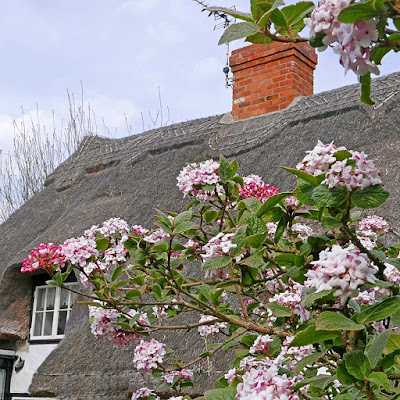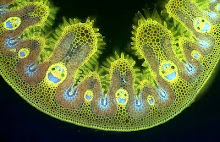Friday, July 15, 2016
Thursday, April 14, 2016
Viburnum x burkwoodii, Adoxaceae
When I first saw this wonderful shrub growing in a garden near Cambridge this week I thought it was Viburnum x burkwoodii but when I posted a picture on Twitter Alan Gardner @autisticgardner identified it as V. carlesii 'Aurora', so now I'm not so sure.
Either way, it makes a wonderful display in April and filled this sheltered garden with a delightful spicy scent.
V. x burkwoodii is a hybrid between V. carlesii and V. utile, produced by Arthur and Albert Burkwood in the 19th. century. I though it might be this because V. carlesii only grows to about 1.5m. tall while this is about 2.5m., although it does have some of the intense pink colouring of the latter species at the bud stage.
In autumn it has bright red fruits that blacken during winter, and the autumn foliage goes a deep shade of red.
All in all, a very desirable shrub, whatever species or hybrid it might be. It's a native of Korea and Japan.
Labels:
Adoxaceae,
Viburnum carlesii,
Viburnum x burkwoodii
Thursday, April 10, 2014
Erythronium 'Pagoda', Liliaceae
Few spring flowers have such grace and elegance as Erythronium 'Pagoda', right from the time that the buds form to the moment when the sulphur yellow tepals open and curl backwards.
It's an easy plant to grow, thriving in permanently moist soil in the dappled shade of deciduous trees. The only problem is remembering where the bulbs have been planted after the flowers and foliage die back in summer - it's easy to forget and accidentally dig them up. Left undisturbed, it steadily increases forming very attractive carpets of spring foliage and flowers.
The genus Erythronium has a northern temperate distribution, with around twenty two species that are mostly found in deciduous woodlands. There is a very good series of Scottish Rock Garden Club articles by Ed Alverson describing the North American species in their natural habitat and including some very fine photographs, which you can access by clicking here, here, here, here, and here.
Erythronium is often called the trout lily or dog's tooth violet, the latter name referring to the tooth-like shape of the bulbs rather than the flowers. The name trout lily refers to the similarity between the mottling on the leaves and the skin markings of trout.
Labels:
dog's tooth violet,
Erythronium,
Liliaceae,
trout lily
Sunday, November 24, 2013
Broad bean aka faba bean, Vicia faba, Fabaceae
Few seeds have such a pleasing shape as freshly shelled broad beans and I cannot think of another vegetable crop which has such fragrant flowers. I spent several years of my professional career working on the reproductive biology of this crop, alongside plant breeders who were trying to breed higher yielding, more stable varieties.
Part of the secret of high yields is effective pollination. The crop has a strange breeding system, where some of the plants are capable of self pollination (so-called autofertiles) and others (known as autosteriles) require cross pollination by bees. Cross pollinated plants produce offspring capable of self pollination and offspring of self pollinated plants are autosteriles that require bee pollination, so the proportion of each type, and therefore the number of plants that need bees to pollinate their flowers, varies between generations - leading to fluctuating yields in successive crops.
But always the key to a good yield is good pollination ...
......... and for that you need plenty of bumblebees, because honeybees aren't really robust enough to be effective pollinators.
The bumblebee needs to land on the keel petal and force it downwards to reach the pollen, and then extends its tongue to reach the nectar which is at the back of the corolla tube. As it does so ....
.... the stigma and stamens are released from the keel petals that envelope them and pollen is transferred to the bee and broad bean stigma, so .......
....... flowers that have been well and truly bumblebee pollinated look like this after the bee moves on. That requires quite a lot of effort on the part of the bee ...
.... but bumblebees are smart and some learn to be nectar thieves, biting a hole in the corolla tube and using their long tongues to extract the nectar without tripping the flower.
Vicia faba flowers are exquisitely fragrant and to stand in a field of them in full bloom on a summer morning is a memorable experience.
There is quite a lot of flower colour variation in this species, with pure white flowers in some varieties and - more rarely - plants with purple or yellow wing petal spots. There's also considerable variation in seed size, from the small-seeded paucijuga types that are grown in North Africa, through the larger seeded equina 'horse beans' (aka field beans) that are grown for animal feed, to the large-seeded broad bean types that are grown as a vegetable.
Plant breeders only have the genetic variation within the cultivated crop to work with - Vicia faba is a cultigen, an ancient crop of unknown origin with no known wild populations. What's more, it will not cross with related wild Vicia species, so the pool of genetic variabilty that plant breeders have to their disposal is strictly limited.
Image source: http://en.wikipedia.org/wiki/File:Illustration_Vicia_faba1.jpg
Labels:
broad bean,
bumblebees,
faba bean,
Fabaceae,
nectar theft,
pollination,
Vicia faba
Wednesday, October 16, 2013
Decaisnea fargesii, Dead Man's Fingers, Lardizabalaceae
Mention the word 'autumn' and what colours spring to mind? Most likely crimson, scarlet, orange, yellow, russet, gold ......... but probably not blue. But that's the colour of the eye-catching fruits of Decaisnea fargesii, ripening in Durham University Botanic Garden today.
This large shrub has attractive, long, pinnate leaves ........
...... grey-green below .....
....... and darker green above, but it's those fruits that make it special. It's hardy so I'm surprised it's not more widely planted. The colour of the pods is most vivid on sunny days, so must be partly due to the reflective properties of the pod surface, in addition to the underlying pigmentation.
The seeds are surrounded by a jelly-like pulp that's said to be edible but insipid.
Decaisnea fargesii comes from western China
Subscribe to:
Posts (Atom)
































































